This form is available electronically.
AD-1026
(10-30-14)
(See Page 2 for Privacy Act and Paperwork Reduction Act Statements)
U.S. DEPARTMENT OF AGRICULTURE
FarmServiceAgency
HIGHLY ERODIBLE LAND CONSERVATION (HELC) AND
WETLAND CONSERVATION (WC) CERTIFICATION
Read attached AD-1026 Appendix before completing form.
PART A – BASIC INFORMATION
2. Tax Identification Number (Last 4 digits)
4. Names of affiliated persons with farming interests . Enter “None,” if applicable.
Affiliated persons with farming interests must also file an AD-1026. See Item 7 in the Appendix for a definition of an affiliated person.
5.Check one of these boxes if the statement applies; otherwise continue to Part B.
A.  The producer in Part A does not have interest in land devoted to agriculture. Examples include bee keepers who place their hives on another person’s land, producers of crops grown in greenhouses, and producers of aquaculture AND these producers do not own/lease any agricultural land themselves. Note: Do not check this box if the producer shares in a crop.
The producer in Part A does not have interest in land devoted to agriculture. Examples include bee keepers who place their hives on another person’s land, producers of crops grown in greenhouses, and producers of aquaculture AND these producers do not own/lease any agricultural land themselves. Note: Do not check this box if the producer shares in a crop.
B.  The producer in Part A meets all three of the following:
The producer in Part A meets all three of the following:
·does not participate in any USDA program that is subject to HELC and WC compliance except Federal Crop Insurance.
·only has interest in land devoted to agriculturewhich is exclusively used for perennial crops, except sugarcane, and
·has not converted a wetland after February 7, 2014.
Perennial crops include, but are not limited to, tree fruit, tree nuts, grapes, olives, native pasture and perennial forage. A producer that produces alfalfa should contact the Natural Resources Conservation Service at the nearest USDA Service Center to determine whether such production qualifies as production of a perennial crop.
Note: If either box is checked, and the producer in Part A does not participate in Farm Service Agency(FSA) or Natural Resources Conservation Service (NRCS) programs, the full tax identification number of the producer must be provided, but establishment of detailed farm records with FSA is not required. Go to Part D and sign and date.
PART B - HELC/WC COMPLIANCE QUESTIONS
Indicate YES or NO to each question. |
|
If you are unsure of whether a HEL determination, wetland determination, or NRCS evaluation has been completed, contact your local |
YES NO |
USDA Service Center. |
|
6.During the crop year entered in PartA or the term of a requested USDA loan, did or will the producer in Part A plant or produce an agricultural commodity (including sugarcane) on land for which an HEL determination has not been made?
7.Has anyone performed (since December 23, 1985), or will anyone perform any activities to:
A.Create new drainage systems,conduct land leveling, filling, dredging, land clearing, or excavation that has NOT been evaluated by NRCS? If “YES”,indicate the year(s):
B.Improve or modify an existing drainage systemthat has NOT been evaluated by NRCS? If “YES”,indicate the year(s):
C. Maintain an existing drainage system that has NOT been evaluated by NRCS? If "YES", indicate the year(s):
Note:Maintenance is the repair, rehabilitation, or replacement of the capacity of existing drainage systems to allow for the continued use of wetlands currently in agricultural production and the continued management of other areas as they were used before December 23, 1985. This allows a person to reconstruct or maintain the capacity of the original system or install a replacement system that is more durable or will realize lower maintenance or costs.
Note:If “YES” is checked for Item 7A or 7B, then Part C must be completed to authorize NRCS to make an HELC/WC and/or certified wetland determination on the identified land. If “YES” is checked for Item 7C, NRCS does not have to conduct a certified wetland determination.
8. Check one or both boxes, if applicable; otherwise, continue to Part C or D.
Check this box only if the producer in Part A has FCIC reinsured crop insurance and filing this form represents the first time the producer in Part A, including any affiliated person, has been subject to HELCand WC provisions.
Check this box if either of the following applies to the producer and crop year entered in Part A:
•Is a tenant on a farm that is/will not be in compliance with HELC and WC provisions because the landlord refuses to allow compliance, but all other farms not associated with that landlord are in compliance. (AD-1026B, Tenant Exemption Request, must be completed).
•Is a landlord of a farm that is/will not be in compliance with HELC and WC provisions because of a violation by the tenant on that farm, but all other farms not associated with that tenant are in compliance. (AD-1026C, Landlord or Landowner Exemption Request, must be completed).
PART C – ADDITIONAL INFORMATION
9. If “YES” was checked in Item 6 or 7, provide the following information for the land to which the answer applies:
A.Farm and/or tract/field number:
If unknown, contact the Farm Service Agency at the nearest USDA Service Center.
 B. Activity:
B. Activity:
 C. Current land use (specify crops):
C. Current land use (specify crops):
 D. County:
D. County:
AD-1026 (10-30-14) |
Page 2 of 2 |
PART D – CERTIFICATION OF COMPLIANCE
Ihave received and readthe AD-1026 Appendix and understandandagree to theterms and conditionstherein on all land in which I (or the producer in Part A if different) and any affiliated person have or will have an interest. I understandthat eligibility for certain USDA program benefits is contingent upon this certification of compliance with HELC and WC provisions andI am responsible for any non-compliance. I understand and agree that this certification of compliance is considered
continuous and will remain in effect unless revoked or a violation is determined. I further understand and agree that:
· all applicable payments must be refunded if a determination of ineligibility is made for a violation of HELC or WC provisions.
· NRCS may verify whether a HELC violation or WC has occurred.
· a revised Form AD-1026 must be filed ifthere are any operation changes or activitiesthat may affect compliance with the HELC and WC provisions. I
understand that failure to revise Form AD-1026 for such changes may result in ineligibility for certain USDA program benefits or other consequences.
· affiliatedpersons are also subject to compliance with HELC and WC provisions and their failure to comply or file Form AD-1026 will result in loss of eligibility for applicable benefits to any individuals or entities with whom they are considered affiliated.
Producer’s Certification:
I hereby certify that the information on this form is true and correct to the best of my knowledge.
10A. Producer’s Signature (By) |
10B. Title/Relationship (If Signing in Representative Capacity) |
10C. Date (MM-DD-YYYY) |
|
|
|
FOR FSA USE ONLY(for referral to NRCS) |
11A. Signature of FSA Representative |
11B. Date (MM-DD-YYYY) |
|
|
Sign and date if NRCS determination is needed. |
|
|
|
|
|
IMPORTANT: If youare unsure about the applicability of HELCand WCprovisionsto your land, contact your local USDA Service Center for details concerningthe location of anyhighly erodible land or wetlandand anyrestrictions applyingto your landaccording to NRCS determinations before plantingan agricultural commodity or performingany drainage or manipulation. Failure to certify and properly revise your compliancecertification when applicable may: (1) affect your eligibility for USDA program benefits, including whether you qualify for reinstatement of benefits through the Good Faith process; and (2)result in other consequences.
|
NOTE: |
The following statement is made in accordance with the Privacy Act of 1974 (5 USC 552a - as amended). The authority for requesting the information identified on this |
|
form is 7 CFR Part 12, the Food Security Act of 1985 (Pub. L. 99-198), and the Agricultural Act of 2014 (Pub. L. 113-79). The information will be used to certify |
|
|
|
|
compliance with HELC and WC provisions and to determine producer eligibility to participate in and receive benefits under programs administered by USDA agencies. |
|
|
The information collected on this form may be disclosed to other Federal, State, Local government agencies, Tribal agencies, and nongovernmental entities that have |
|
|
been authorized access to the information by statute or regulation and/or as described in applicable Routine Uses identified in the System of Records Notice for |
|
|
USDA/FSA-2, Farm Records File (Automated) and USDA/FSA-14, Applicant/Borrower. Providing the requested information is voluntary. However, failure to furnish the |
|
|
requested information will result in a determination of producer ineligibility to participate in and receive benefits under programs administered by USDA agencies. |
|
|
This information collection is exempted from the Paperwork Reduction Act as specified in the Agricultural Act of 2014 (Pub. L. 113-79, Title II, Subtitle G, Funding |
|
|
and Administration). The provisions of appropriate criminal and civil fraud, privacy, and other statutes may be applicable to the information provided. RETURN |
|
|
THIS COMPLETED FORM AD-1026 TO YOUR COUNTY FARM SERVICE AGENCY (FSA) OFFICE. |
The U.S. Department of Agriculture (USDA) prohibits discrimination against its customers, employees, and applicants for employment on the basis of race, color, national origin, age, disability, sex, gender identity, religion, reprisal, and where applicable, political beliefs, marital status, familial or parental status, sexual orientation, or all or part of an individual’s income is derived from any public assistance program, or protected genetic information in employment or in any program or activity conducted or funded by the Department. (Not all prohibited basis will apply to all programs and/or employment activities.) Persons with disabilities, who wish to file a program complaint, write to the address below or if you require alternative means of communication for program information (e.g., Braille, large print, audiotape, etc.) please contact USDA’s TARGET Center at (202) 720-2600 (voice and TDD). Individuals who are deaf, hard of hearing, or have speech disabilities and wish to file either an EEO or program complaint, please contact USDA through the Federal Relay Service at (800) 877-8339 or (800) 845-6136 (in Spanish).
If you wish to file a Civil Rights program complaint of discrimination, complete the USDA Program Discrimination Complaint Form, found online at http://www.ascr.usda.gov/complaint_filing_cust.html, or at any USDA office, or call (866) 632-9992 to request the form. You may also write a letter containing all of the information requested in the form. Send your completed complaint form or letter by mail to U.S. Department of Agriculture, Director, Office of Adjudication, 1400 Independence Avenue, S.W., Washington, D.C. 20250-9410, by fax (202) 690-7442 or email at program.intake@usda.gov. USDA is an equal opportunity provider and employer.
This form is available electronically.
AD-1026 Appendix |
U.S. DEPARTMENT OF AGRICULTURE |
(10-30-14) |
FarmServiceAgency |
|
APPENDIX TO FORM AD-1026 |
|
HIGHLY ERODIBLE LAND CONSERVATION (HELC) AND |
|
WETLAND CONSERVATION (WC) CERTIFICATION |
1.Overview
The following conditions of eligibility are required for a producer to receive any U.S. Department of Agriculture (USDA) loans or other program benefits that are subject to the highly erodible land conservation (HELC) and wetland conservation (WC) provisions. Unless an exemption has been granted by USDA, the producer agrees to all of the following on all farms in which the producer, and any affiliated person to the producer (as specified in 7 CFR Part 12), has an interest:
·NOT to plant or produce an agriculturalcommodity on highly erodible land or fields unless being farmed in accordance with a conservation plan or system approved by the Natural Resources Conservation Service.
·NOT to plant or produce an agriculturalcommodity on a wetland that was converted after December 23, 1985.
·NOT to have converted a wetland after November 28, 1990, for the purpose, or to have the effect, of making the production of an agricultural commodity possible on such converted wetland.
·NOT to convert a wetland by draining, dredging, filling, leveling, removing woody vegetation, or any other activity that results in impairing or reducing the flow and circulation of water in a way that would allow the planting of an agricultural commodity.
·NOT to use proceeds from any Farm Service Agency farm loan, insured or guaranteed, or any USDA financial assistance program, in such a way that might result in negative impacts to a wetland, except for those projects evaluated and approved by Natural Resources Conservation Service.
2.Statutory and Regulatory Authority
The Food Security Act of 1985, as amended, requires producers participating in most programs administered by the Farm Service Agency (FSA), Natural Resources Conservation Service (NRCS), and the Risk Management Agency (RMA) to comply with HELC and WC provisions on all land owned or farmed that is considered highly erodible or a wetland unless USDA determines an exemption applies. Producers participating in these programs, and any individualor entity considered to be an affiliated person of a participating producer, are subject to these provisions. The regulations covering these provisions are set forth at 7 CFR Part 12; all such provisions, whether or not explicitly stated herein, shall apply.
3.Explanation of Terms
Agriculturalcommodity is any crop planted and produced by annual tilling of the soil, including tilling by one-trip planters, or sugarcane.
Highly erodible land is any land that has an erodibility index of 8 or more. Highly erodible fields are fields where either:
·33.33 percent or more of the total field acreage is identified as soil map units that are highly erodible; or
·50 or more acres in such field are identified as soil map units that are highly erodible.
Perennial crop is any crop that is planted once and produces crops over multiple years. Go to
www.nrcs.usda.gov/compliance for a list of perennial and annual crops.
Wetland is an area that:
·has a predominance of hydric soils (wet soils);
·is inundated or saturated by surface or groundwater (hydrology) at a frequency and duration sufficient to support a prevalence of hydrophytic (water tolerant) vegetation typically adapted for life in saturated soil conditions; and
·under normal circumstances supports a prevalence of such vegetation, except that this term does not include lands in Alaska identified as having a high potential for agricultural development and a predominance of permafrost soils.
AD-1026 Appendix (10-30-14) |
Page 2 of 3 |
4. NRCS and FSA Determinations
When making HELC and WC compliance determinations:
·NRCS makes technical determinations; these include:
§For HELC compliance:
§whether land is considered highly erodible;
§establishing conservation plans or systems; and
§whether highly erodible fields are being farmed in accordance with a conservation plan or system approved by NRCS.
§For WC compliance:
§whether land is a wetland and if certain technical exemptions apply, such as prior converted;
§whether a wetland conversion has occurred.
·FSA’s responsibilities include:
·making eligibility determinations, such as who is ineligible based upon NRCS technical determinations of non-compliance.
·acting on requests for application of certain eligibility exemptions, such as the good faith relief exemption.
·maintaining the official USDA records of highly erodible land and wetland determinations. The determinations are recorded both within the geographic information system and the automated farm and tract records maintained by FSA; however, it is important to know that determinations may not include all of a producer’s land. If a producer is uncertain of the highly erodible land and wetland determinations applicable to any of the producer’s land, the producer should contact the appropriate USDA Service Center for assistance.
5.HELC and WC Non-Compliance - FSA and NRCS Programs
Producers who are not in compliance with HELC and WC provisions are not eligible to receive benefits for most programs administered by FSA and NRCS. If a producer received program benefits and is later found to be non-compliant, the producer may be required to refund all benefits received and/or may be assessed a penalty.
In particular, unless exemptions apply, a producer participating in FSA and NRCS programs must: not plant or produce an agricultural commodity on a highly erodible field unless such production is in compliance with a conservation plan or system approved by NRCS; not have planted or produced an agricultural commodity on a wetland converted after December 23, 1985; and, after November 28, 1990, must not have converted a wetland for the purpose, or to have the effect, of making the production of an agricultural commodity possible on such converted wetland.
A producer who violates HELC or WC provisions is ineligible for applicable FSA and NRCS benefits for the year(s) in violation. A planting violation, whether on highly erodible land or a converted wetland, results in ineligibility for benefits for the year(s) when the planting occurred. A wetland conversion violation results in ineligibility beginning with the year in
which the conversion occurred and continuing for subsequent years, unless the converted wetland is restored or mitigated before January 1st of the subsequent year.
6.HELC and WC Non-Compliance - Risk Management Agency - Crop Insurance Policies Reinsured by the Federal Crop Insurance Corporation
Producers obtaining federally reinsured crop insurance will not be eligible for any premium subsidy paid by the Federal Crop Insurance Corporation (FCIC) for any policy or plan of insurance if the producer:
·has not filed a completed Form AD-1026 with FSA certifying compliance with HELC and WC provisions; or
·is not in compliance with HELC and WC provisions.
Unless an exemption applies, a producer must:
·not plant or produce an agricultural commodity on a highly erodible field, unless such production is in compliance with a conservation plan approved by NRCS;
·not plant or produce an agricultural commodity on a wetland converted after February 7, 2014; and
·not have converted a wetland for the purpose, or to have the effect, of making the production of an agricultural commodity possible on such converted wetland after February 7, 2014.

AD-1026 Appendix (10-30-14) |
Page 3 of 3 |
A producer is ineligible for any premium subsidy paid by FCIC on all policies and plans of insurance for the reinsurance year (July 1 – June 30) following the reinsurance year of a final determination of a violation of HELC or WC provisions, including all administrative appeals, unless specific exemptions apply. Further, a producer will be ineligible for any premium subsidy paid by FCIC on all policies and plans of insurance for a reinsurance year if they do not have a completed Form AD-1026 on file with FSA certifying compliance on or before the June 1 prior to the beginning of the subsequent reinsurance year (July 1), unless otherwise exempted. RMA will contact FSA to determine compliance with HELC and WC provisions and the filing of Form AD-1026 prior to the beginning of a reinsurance year, which begins on July 1. If the producer is not in compliance and is not exempt, the producer will be ineligible for premium subsidy for all crops with a sales closing date between the following July 1 through the next June 30.
7. Affiliated Persons
Any affiliated person of a producer requesting benefits subject to HELC and WC provisions must also be in compliance with those provisions. Ineligibility of a producer will also apply to affiliated persons of that producer. If an affiliated person has a farming interest (as owner, operator, or other producer on any farm), the affiliated person must also file Form AD-1026 certifying compliance with HELC and WC provisions in order for the producer requesting benefits to be eligible.
Use this table to determine affiliated persons who must be in compliance with HELC and WC provisions and file Form AD-1026. If you are unsure about an affiliated person determination, please contact FSA at your local USDA Service Center for assistance.
IF the producer requesting |
THEN affiliated persons with farming interests who must be in compliance with HELC and WC |
benefits is a (an) . . . |
provisions and file Form AD-1026 are. . . |
|
|
individual |
spouses or minor children with separate farming interests, or who receive benefits under their |
|
individual ID number. |
NOTE: For a minor, parents |
|
estates, trusts, partnerships, and joint ventures in which the individual filing, or the individual’s spouse or |
or guardians shall be listed |
minor children have an interest. |
as affiliated persons . |
|
corporations in which the individual filing or the individual's spouse or minor children have more than |
|
20% interest. |
|
|
general partnership |
first level members of the entity. |
limited partnership |
|
limited liabilitycompany |
|
joint venture |
|
estate |
|
irrevocable or revocable trust |
|
Indian tribal venture or group |
|
|
|
|
first level shareholders with more than 20% interest in the corporation. |
corporation with stockholders |
Note: First level shareholders of a corporation with 20% interest or less in the corporation are not |
|
|
considered affiliated persons of the corporation. |
IMPORTANT NOTICE:
Signature on Form AD-1026 gives representatives of USDA authorization to enter upon and inspect all farms in which the producer in Part A of Form AD-1026 has an interest for the purpose of confirming HELC and WC compliance.
NOTE: |
The following statement is made in accordance with the Privacy Act of 1974 (5 USC 552a - as amended). The authority for requesting the information identified on |
|
this form is 7 CFR Part 12, the Food Security Act of 1985 (Pub. L. 99-198), and the Agricultural Act of 2014 (Pub. L. 113-79). The information will be used to certify |
|
compliance with HELC and WC provisions and to determine producer eligibility to participate in and receive benefits under programs administered by USDA |
|
agencies. The information collected on this form may be disclosed to other Federal, State, Local government agencies, Tribal agencies, and nongovernmental |
|
entities that have been authorized access to the information by statute or regulation and/or as described in applicable Routine Uses identified in the System of |
|
Records Notice for USDA/FSA-2, Farm Records File (Automated) and USDA/FSA-14, Applicant/Borrower. Providing the requested information is voluntary. |
|
However, failure to furnish the requested information will result in a determi nation of producer ineligibility to participate in and receive benefits under programs |
|
administered by USDA agencies. |
|
This information collection is exempted from the Paperwork Reduction Act as specified in the Agricultural Act of 2014 (Pub. L. 113-79, Title II, Subtitle G, Funding and |
|
Administration). The provisions of appropriate criminal and civil fraud, privacy, and other statutes may be applicable to the information provided. RETURN THE |
|
COMPLETED FORM AD-1026 TO YOUR COUNTY FARM SERVICE AGENCY (FSA) OFFICE. |
The U.S. Department of Agriculture (USDA) prohibits discrimination against its customers, employees, and applicants for employment on the basis of race, color, national origin, age, disability, sex, gender identity, religion, reprisal, and where applicable, political beliefs, marital status, familial or parental status, sexual orientation, or all or part of an individual’s income is derived from any public assistance program, or protected genetic information in employment or in any program or activity conducted or funded by the Department. (Not all prohibited basis will apply to all programs and/or employment activities.) Persons with disabilities, who wish to file a program complaint, write to the address below or if you require alternative means of communication for program information (e.g., Braille, large print, audiotape, etc.) please contact USDA’s TARGET Center at (202) 720-2600 (voice and TDD). Individuals who are deaf, hard of hearing, or have speech disabilities and wish to file either an EEO or program complaint, please contact USDA through the Federal Relay Service at (800) 877-8339 or (800) 845- 6136 (in Spanish).
If you wish to file a Civil Rights program complaint of discrimination, complete the USDA Program Discrimination Complaint Form, found online at http://www.ascr.usda.gov/complaint_filing_cust.html, or at any
USDA office, or call (866) 632-9992 to request the form. You may also write a letter containing all of the information requested in the form. Send your completed complaint form or letter by mail to U.S. Department of Agriculture, Director, Office of Adjudication, 1400 Independence Avenue, S.W., Washington, D.C. 20250-9410, by fax (202) 690- 7442 or email at program.intake@usda.gov. USDA is an equal opportunity provider and employer.
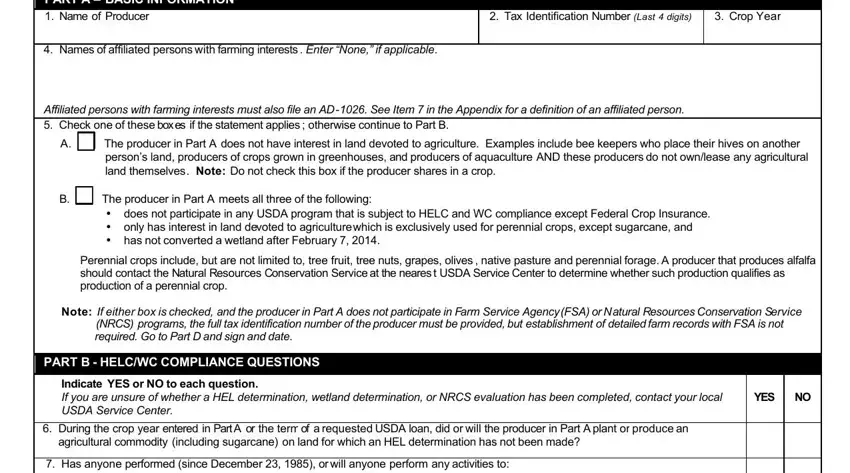
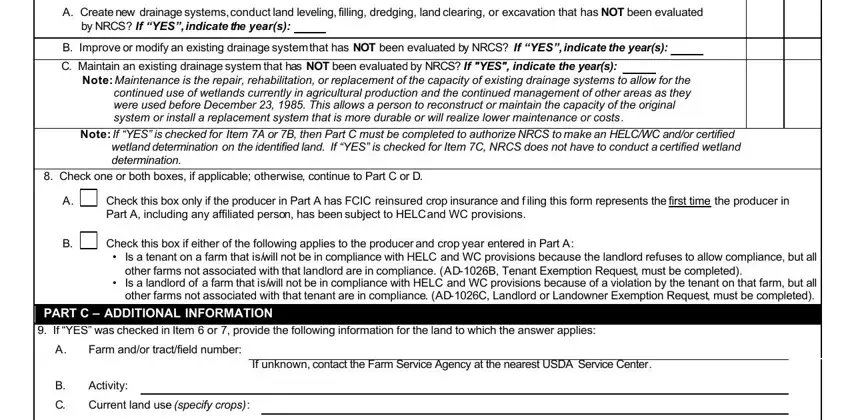
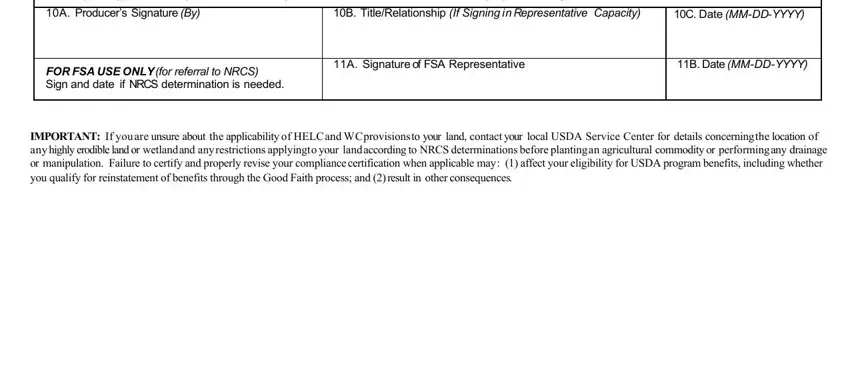
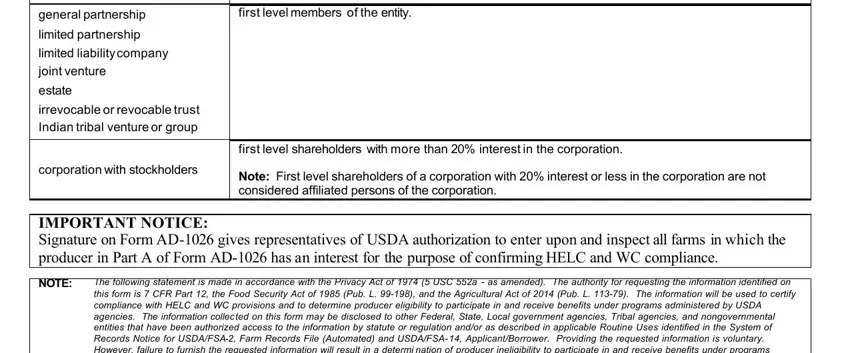
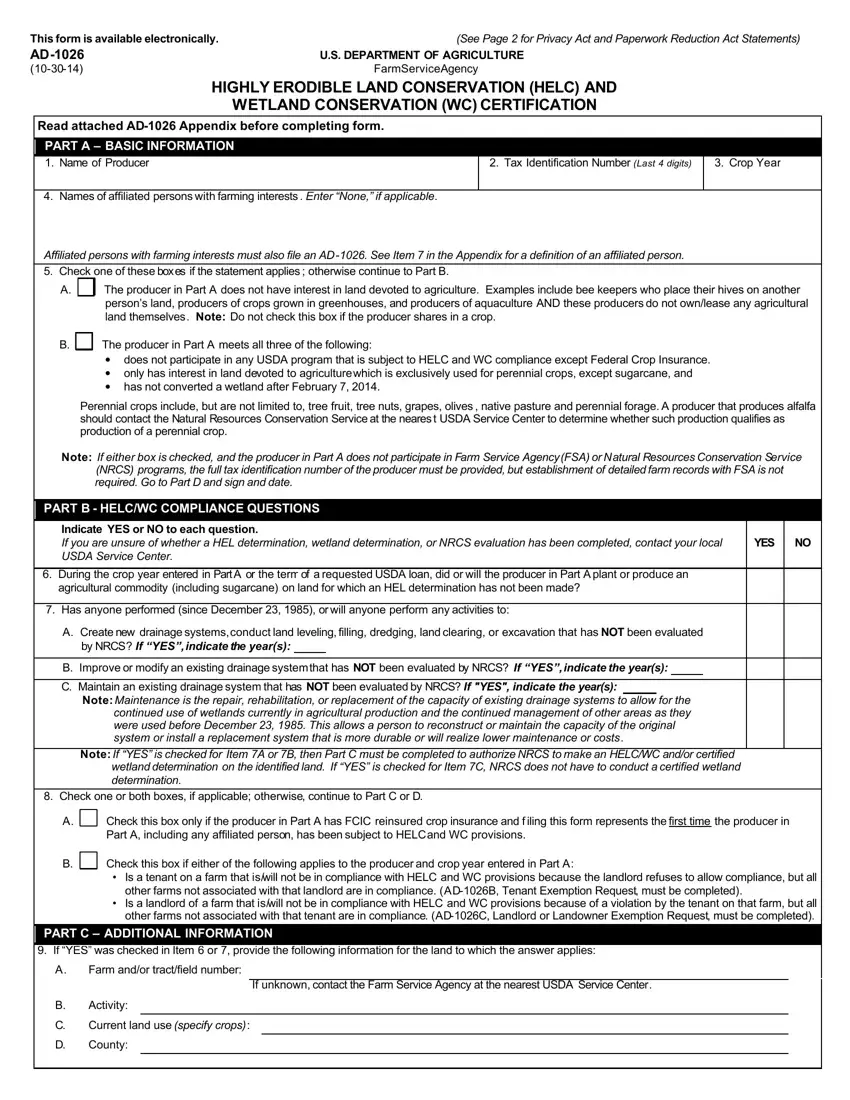

 The producer in Part A does not have interest in land devoted to agriculture. Examples include bee keepers who place their hives on another person’s land, producers of crops grown in greenhouses, and producers of aquaculture AND these producers do not own/lease any agricultural land themselves.
The producer in Part A does not have interest in land devoted to agriculture. Examples include bee keepers who place their hives on another person’s land, producers of crops grown in greenhouses, and producers of aquaculture AND these producers do not own/lease any agricultural land themselves.  The producer in Part A meets all three of the following:
The producer in Part A meets all three of the following:




